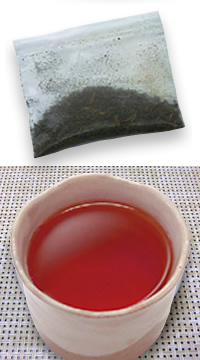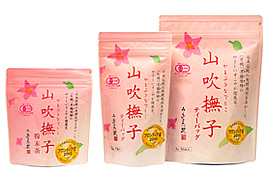Our Varieties
Our products cover a wide range of Japanese teas, from traditional styles of Japanese green tea to Shizuoka's original tastes. The list below shows only a part of them.
Sencha : 煎茶 (high-grade short-steamed leaf tea)

Sencha is made of young tea leaves picked in quality season (typically first flush, picked during April and May). After being slightly steamed (for about 10-30 seconds), harvested leaves are rolled and dried to form sharp, needle-like aracha (荒茶 crude tea). Then, aracha is typically blended and mildly roasted to yield unique aroma (Hika) and becomes final sencha.
Traditionally lightly-steamed sencha is the most preferred tea in Japan. Nearly-boiling water extracts steady astringency of catechin (tannin), greenish scent and sinewy body, while hot water at a lower temperature extracts a soothing and mellow flavor. The hue of tea varies from light-gold to light-green, depending on the steaming time.
Sencha has been a top seller in our catalogue and over 80% of our tea trade deals in sencha. We also have rare organic sencha in stock which is certified by JAS standards for organic products.
* The word "sencha" literally means "a tea prepared by simmering". In a broad sense, hence, it includes fukamushicha and even gyokuro. In order to distinguish sencha from fukamushicha, sencha is sometimes referred as "asamushi sencha" (浅蒸し煎茶) in the Japanese tea market.
Fukamushicha : 深蒸し茶 (high-grade deep-steamed leaf tea)

The manufacturing process of fukamushicha is quite similar to that of sencha except that this tea is steamed relatively long time (for about 1-3 min). This method was originally established in Kakegawa city in Shizuoka, and it enables the extraction of a less astringent, mild and complex flavor consisted of a variety of amino acids. Fukamushicha has a deep green hue. The weaker scent of grass is supplemented with a stronger Hika aroma.
Fukamushicha tends to be regarded as a rather lower-grade tea than lightly-steamed sencha for the shape of fukamushicha tends to be more irregular and looks dustier than that of lightly-steamed sencha. However, fukamushicha these days has achieved mainstream popularity thanks to its mild and quaffable taste.
MURACO offers a high-grade Fukamushicha which is made in its birthplace, Kakegawa city.
Gyokuro : 玉露 (top-grade shade-grown leaf tea)

Gyokuro, literally meaning "jewel dew", is the finest and most expensive grade of sencha. In contrast with ordinary senchas, usually made of Yabukita leaves, gyokuro is sometimes made from special kinds of tea plants such as Asahi, Okumidori, Yamakai, and Saemidori. By carefully shading tea plants for 20 days before picking, tea growers allow tea leaves to have soft texture, light-green color, far-richer glutamic acid, theanine, caffeine and less catechin (tannin). Shading also adds gyokuro a characteristic seaweed-like aroma (かぶせ香 Kabuse-ka).
Infusing gyokuro requires water heated at a quite low temperature and long steeping time, which enable the extraction of a surprisingly dense and rich flavor. Its taste is sometimes described as thick and fulfilling as a cup of soup, and its lasting sweetness gives another delight.
Guricha : ぐり茶 (curly leaf tea)

Guricha is a quite unique kind of Sencha, which is made only in Shizuoka and Kumamoto prefectures these days. Because of the deep steaming and simplified rolling processes, guricha leaves are not roughly torn as much as sencha leaves; they are rolled into curly leaves as "Guri" means "curled".
Since guricha originally aimed to be a competing product to be exported to the Soviet Union and East-European countries in 1930s, the growers intentionally made its looks similar to Chinese-style pan-dried green teas, which were very popular in these countries at the time. Guricha also has flavors that remind you of Chinese green teas in its refreshing pan-dry aroma, light and soothing taste and weak astringency.
Guricha remains little-known outside its production places in Japan today; however, we often receive favorable reviews for its quality in the international market, and we constantly export regular amounts to our international clients.
Houjicha : ほうじ茶 (Roasted leaf tea)

Houjicha is a variety of Japanese green tea, generally referring to a tea made by roasting green teas. While typical houjicha is made from common grade bancha, some fine houjicha is made from sencha. The extraordinarily strong roasting process turns the color of tea leaves dark brown, and hence the hue of tea becomes reddish-brown or light-brown. Roasting teas at a high temperature (around 130-150C) gets rid of most of caffeins and catechins while preserving teanine-derived sweetness and creates a Houjicha's characteristic roasted aroma (焙じ香 Houjikou).
Houjicha is an inexpensive, humble tea which fits into every occasion. You can drink it as refreshment at the workplace, during a meal or just before going to bed. A plain and clear taste is beloved of everyone, including children and elderly people.
We offer fine grade houjicha made from blended sencha and bancha.
Genmaicha : 玄米茶 (Tea with roasted rice)

Genmaicha is a kind of traditional flavored tea, typically made with bancha and popped or roasted unpolished rice (玄米 genmai). Its distinctly nutty flavor makes genmaicha a unique but universally acceptable tea. Some high-class genmaicha would be blended with matcha to add a richer taste and greener hue.
Japanese restaurants often serve genmaicha as a starter drink in, since the aroma of roasted rice stimulates one’s appetite. Genmaicha is also delicious when served cold.
Amongst the several grades of genmaicha MURACO deals with, we confidently recommend the highest quality genmaicha, which are carefully made with all organically-grown sencha, matcha and unpolished rice.
Matcha : 抹茶 (Powdered green tea)

Matcha is a finely milled powdered tea, mainly served at the Japanese tea ceremony. Matcha is made from a special type of semifinished green tea called tencha (碾茶 non-rolled steamed green tea). Similar to gyokuro, tea leaves for tencha are shade-grown for about 20 days before being harvested. This allows tea leaves to increase amino acids, reduce tannin-derived astringency and retain a deep green hue. Usually hand-picked finest tips, orange pekoes and pekoes (一芯二葉 isshin-niyo), are used for tencha.
After being steamed, the leaves are only thermal-dried in a dryer (碾茶炉 tencha-ro) without going through a rolling process, to become roughly crumbled tencha. Then, a tea processor refines tencha minutely by removing veins and stems, and different types of refined tencha are blended to standardize a product quality. Finally, blended tencha is stone-ground to a bright-green matcha powder.
Even though it is only partly known, Shizuoka is the third-largest producing prefecture of matcha after Aichi and Kyoto. We deliver the finest quality matcha, carefully grown and finished in the Honyama area.
Wakoucha : 和紅茶 (Japanese black tea)

"Wakoucha" is a nickname recently given to black teas made in Japan ("Wa" means Japanese, and "Koucha" means black tea). Even though most Japanese people have forgotten nowadays, Japanese black teas in fact have over 130 years of history as an export product. Japanese black teas were once a major trade item of Japan from mid-Meiji era to mid-Showa era (1880-1950). The gross production amount per year exceeded 8500 tons at the peak.
Though economic growth after WWII and accompanying inflation made Japanese black teas non-competitive in the global market, some growers retained black-tea manufacturing and recently succeeded in reviving the production renaming it as "wakoucha". Almost all recent wakoucha target the domestic tea market and it steadily increases their fans.
Cultivars grown for producing wakoucha vary widely, namely, Yabukita (やぶきた dominant cultivar for sencha), Beni-homare (紅ほまれ recent cultivar for black teas), Beni-fuuki (紅富貴 contemporary cultivar for both green and black teas), and Assam hybrid. Most Wakoucha has a bright reddish hue, flowery flavor, little astringency, soft and smooth taste and slightly sweet aftertaste.
MURACO deals with quite rare certified organic Yabukita wakoucha made in the Harunocho Isagawa district. Our wakocha is perfectly balanced, graceful black tea as some traders describe our tea as resembling quality season teas from Nuwara-Elliya or Kandy".
Yamabuki-nadeshiko : 山吹撫子 (Japanese fermented dark tea)

"Yamabuki-nadeshiko" is a brand-new variety of Pu'er-style fermented dark tea which is produced by Osada-Seicha, our partner tea factory.
Yamabuki-nadeshiko is made from organic Japanese green tea leaves harvested in Harunocho Isagawa district of Shizuoka Prefecture, and carefully cultured and patented special strain of Kuro-Kouji-kin (黒麹菌 : Aspergillus awamori Nakazawa), which has been traditionally used in Awamori (Spirit of Okinawa) fermentation in Japan.
By applying Kuro-Kouji-kin as fermentation starter in a cleanroom, specially dedicated for Yamabuki-nadeshiko, and strictly keeping ideal microbial environment with a state-of-the-art Japanese technology, we completely removed the musty odor of typical Pu'er tea, while enhancing all favourable character of fermented dark tea.
Yamkabuki-nadeshiko tea has beautiful ruby hue, mild aroma, and clear, smooth taste. The tea is also good for your health and diet since it contains more gallic acid, citric acid and less caffeine than usual green tea.


All Yamabuki-nadeshiko products are approved by Japanese Agricultural Standard Organic Foods, and able to be shipped both in tea bag style and powdered tea style. We confidently recommend this new style of Japenese tea.
